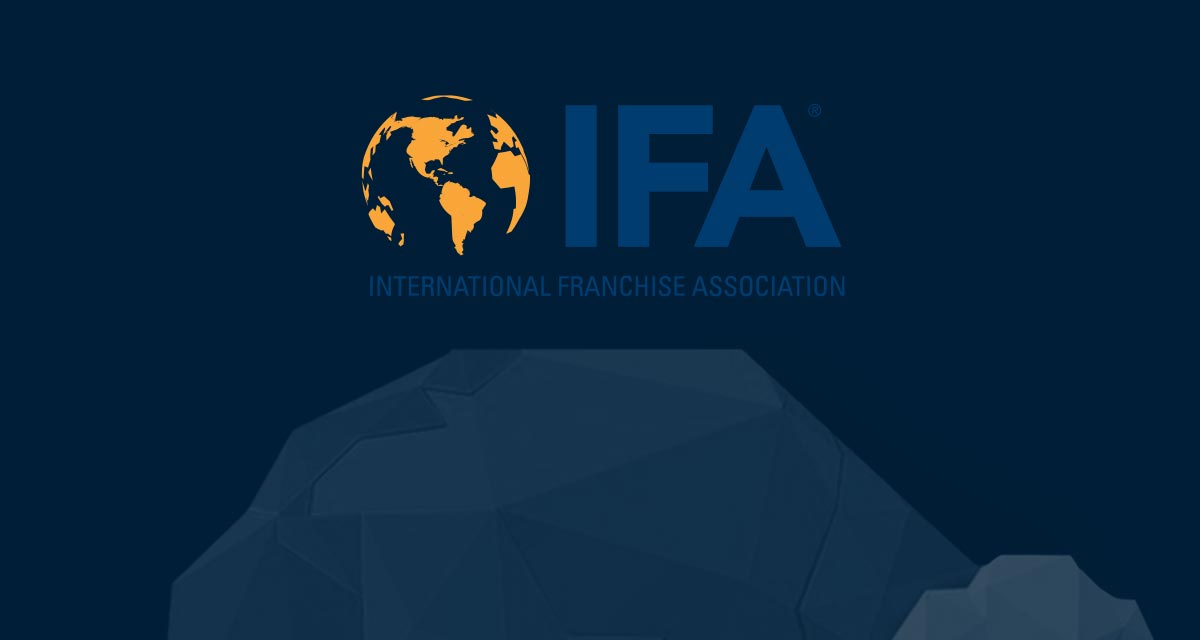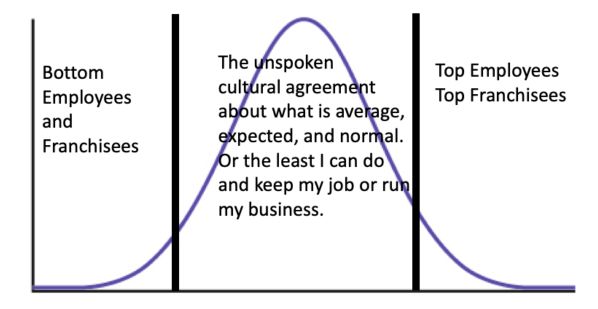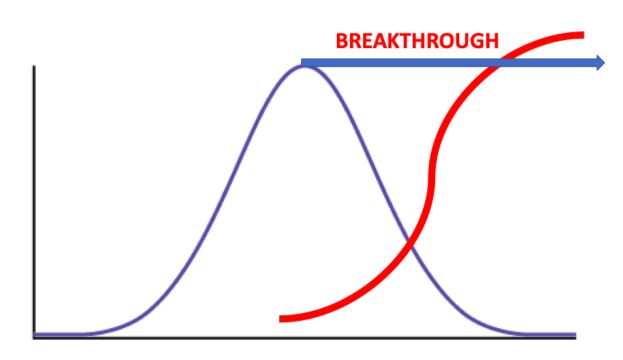
Each year at the IFA, breakout sessions and roundtables cover a wide variety of topics. You can tell where franchisors are struggling by looking at which sessions and tables are jam-packed. This year I observed some of the best franchise sales content I’ve witnessed in 20+ years, facilitated by a skilled moderator and delivered by a panel of seasoned career franchisee recruitment professionals. Yet the room was half-empty. I then walked over early to the session delivered by Chris McChesney, management consultant and author of the Wall Street Journal No. 1 best-seller The 4 Disciplines of Execution. The room was empty at the time and McChesney was doing his sound checks. He walked up to Kevin Cushing, President of the Allegra Network, and me to chat. We told him we were looking forward to his session and that it would soon be packed. He asked us how we could know that. We told him that we are currently in the least entrepreneurial economy in the last 50 years. The U.S. Census Bureau reports that the number of new business starts has significantly declined. We informed him that most people start businesses in an economic downturn due to high opportunity cost in the job market and stock market, as well as other factors. We discussed how a franchisor’s best opportunity to drive revenue is by helping franchisees capture a disproportionate share of this rapidly expanding economy. As we suspected, by the time McChesney started, it was standing-room only. Then McChesney delivered one of the most useful sessions I have attended in my 20 years of conference attendance. I will summarize my takeaways here.
Any franchise system is going to have its bell curve of performance. A bell curve bulges in the middle because different people, faced with the same system and set of circumstances, more often than not, produce similar results. Why is that? FPG describes the phenomenon this way:

Franchisors often think of the bell curve differently: “Franchisees to the right are following the system. Franchisees to the left are screwing the system up. Franchisees in the middle may be following the system, but not as well as franchisees to the right.”That’s because franchisors define the system as their franchise operating system
FPG and McChesney take a broader view. We define the entire bell curve and all the contributing players, products, and processes as one giant brand ecosystem, which creates a series of cause-and-effect relationships with marketing, franchisee recruitment, training, and support. These elements ultimately work together to determine the entire franchisor’s performance bell curve as it now sits. The franchisor’s operating system is merely an element of the larger system.
McChesney and FPG would say it’s the role of leadership to create a breakthrough, which we define as moving the entire bell curve to the right, where low performers now perform like middle performers, middle performers produce like top performers, and top performance break records, as depicted by the red line below.

McChesney taught that creating an organizational breakthrough starts by creating a breakthrough in franchisee and franchisor engagement. Franchisors cannot dictate emotional engagement. Doing so only creates a command-and-control compliance culture, which franchisees and some employees will predictably resist, setting up self-imposed barriers to desired organizational change.
5 Levels for Creating and Sustaining a Breakthrough
McChesney identified 5 linear phases that organizations progress through that lead to sustained organizational change and a breakthrough in results.
Phase One: Leadership desires to improve and change.
Phase Two: Leadership emphasizes certain objectives and initiatives.
Phase Three: The franchisor and, depending on the initiative, franchisees take ownership of the new objectives and initiatives.
Phase Four: Individuals take ownership of their role in furthering leadership’s objectives and initiatives.
Phase Five: Cultural shift occurs and organizational behavior changes. All brand stakeholders systematize and institutionalize the breakthrough, accepting new organizational tactics, beliefs, and breakthrough results as the new normal.
Culture polices itself. So anything the culture defines that is inconsistent with the new normal stands out and is ostracized. McChesney likened corporate culture to antibodies attacking and destroying foreign bodies in the bloodstream.
This also means anywhere along the way in the change process, the brand can and will be met with organizational resistance and pushback from any combination of stakeholders, such as employees, suppliers, and franchisees, until the culture embraces the new normal.
Here is where common organizational breakdowns occur in McChesney’s change model.
Common Franchising Breakdowns Halting Organizational Change
Level One: Brand leadership becomes complacent and loses their ability to accept risk or reinvest. This happens when brand ownership starts to make adequate returns and they shift from playing to win to playing not to lose. Leadership embraces risk mitigation and capital conservation, or large cash distributions to ownership, rather than actualizing available opportunity.
Level Two: The CEO and brand leader keeps redefining what is urgent and important. They get labeled by franchisees and employees as “The Perpetual Big Idea Guys.” When faced with another big idea, secretly employees and franchisees say, “Let’s just wait. They will forget about it in the morning or when the next New York Times best-selling business book comes out.” Another common breakdown occurs when the charismatic, self-deceiving, positive thinking, name-it-claim-it adherent to the book The Secret-brand leadership confuses stated intentions with a new organizational reality and does not resource or successfully execute initiatives.
Level Three: The franchisees and employees of the franchisor don’t buy into the brand leaders’ objectives and either stall or half-heartedly execute, ensuring the initiatives’ demise.
Level Four: Franchisee and franchisor employee naysayers engage in gossip and try to enroll others in their opinion that the new initiatives are not worthwhile pursuits, killing forward momentum and creating lackluster execution and performance.
Level Five: The franchisor leadership does not institutionalize and systematize the breakthrough, and the organization slips back into past beliefs and behavior patterns, creating only a temporary spike in results.
McChesney presented a study that showed the typical organization can properly execute only 2-3 new initiatives at a time. Individuals can only be counted on to execute 1 thing at a time. He showed that brands with the organizational discipline to limit initiatives to the most critical 2 or 3 can count on proper execution. Brand leaders championing 4-10 initiatives will see 1-2 executed well. Leaders with 11-20 will typically see none executed. Less is more.
If this dynamic is true, that requires brand leadership to strategically say no and focus resources and attention on only those initiatives that have the highest probability of moving the bell curve to the right.
4 Proven Strategies That Make Organizational Change Possible
McChesney’s research shows that brands with a culture of excellent execution create organizational change initiatives exhibiting the following 4 characteristics.
- Simplicity. They make the fewest number of moves to achieve their objectives.
- Hyperfocus. One initiative per team creates hyperfocus and negates what McChesney describes as the “whirlwind of normal daily activities.”
- Democracy. Team members can voice their opinion, but cannot dictate a shutdown. The corporate culture allows for everyone to have their say, but once the decision is made, people take ownership of the initiative and move forward as a team.
- Specific deadlines.Organizational goals share a start date and end goal. “We will go from X results to Y results by Z date.”
4 Organizational Disciplines That Drive Results
McChesney asserts corporate cultures that culturally embrace change and continual improvement share these 4 disciplines:
- Focus on what he calls, “The Wildly Important.” This requires brand leadership to take a stand and strategically say no to a vast cornucopia of ideas and limit the organization to the highest-impact initiatives, those most likely to move the performance bell curve to the right.
- They create brand leverage. They choose high organizational impact initiatives that move the bell curve to the right and resist the brand’s tendency to try to solve a litany of one-off break-fix activities.
- Engagement. Employees of the franchisor, suppliers, and franchisees uniformly believe the brand’s goals and initiatives are a worthy pursuit or serve a mighty purpose.
- Accountability. The organization must resource the objective, break goals into bite-sized benchmarks, measure performance, create a feedback loop, and course-correct when necessary.
McChesney and FPG collectively believe the major risk factor any brand faces when implementing change is personal and organizational resistance.
Common Areas of Resistance in Franchising
A franchising system is more than just its operating system, it is the entire universe of customer, supplier, franchisee, franchisor, and competitor cause-and-effect and action-reaction relationships that create the brand’s current bell curve of results.
Franchising is a funny beast. Franchisors count on franchisees as their delivery system to create a valuable customer experience and deliver the brand promise, build consumer-facing brand value and brand equity, and leverage entrepreneurship as a strategic advantage in the marketplace. Yet if entrepreneurs could actually follow processes and systems designed by third parties and respected corporate structure and lines of authority, most likely, THEY WOULD HAVE JOBS. THAT’S WHAT A GOOD EMPLOYEE LOOKS LIKE. Yet somehow franchisors and franchisees falsely believe, “Because franchisees are investing money, this time it will be different. Of course it will be different.” Bull.
11 Common Examples of Resistance in Franchising
Franchisee resistance is a very real element of every franchise brand. It must be continually monitored and managed. Here are some common causes of brand resistance.
- Franchisees don’t feel heard and understood. So they push back.
- Franchisees don’t see what they believe to be their greatest brand challenges resourced properly. So they do their own thing.
- Franchisors create a command-and-control culture that values compliance. Franchisees resist being controlled. And why shouldn’t they? The first question every franchise salesperson asks a franchise candidate is, “Why do you want to start a business?” And they answer in chorus, “I want more control,” not, “I want to be dictated to and dominated.”
- Self-deception. Franchisor leadership operates from their ivory tower and loses touch with what’s going on with their franchisees and customers. Sometimes leaders fail to recognize the impact of disruptive forces and competitive threats.
- Self-sabotage. Perhaps winning causes a false sense of infallibility that prompts leaders to start taking ill-advised risks. Or conversely, leaders freeze and fail to act.
- Fighting. Franchisees and franchisors square off and fight each other for dominance and control instead of fighting competitors for customers and market share.
- Gossip. The people holding the meeting after the meeting dismantle what was agreed to during the meeting. The bathroom conversations nullify the boardroom conversations.
- Confusion. Have you ever been in one of those meetings where it’s like someone lobbed a confusion grenade into the middle of the room, it goes off, and everyone’s IQ gets cut in half and no one seems to know what to do and how to work together?
- Missed, skipped, and postponed meetings. Everyone gets busier doing what they are already doing. McChesney calls this getting caught up in “the whirlwind.”
- Radio silence. People become non-responsive. They ghost. This is a nonverbal, “No, not on my watch” without actually saying it.
- Yessing to death. That’s a yes with no intention attached to it, hoping leadership forgets and goes away.
In summary
Given the intense competition to recruit a relatively small pool of available franchise candidates, franchisors should focus more effort on busting their current bell curve of franchisee performance. The combination of the strong economy, record low unemployment, high consumer confidence, low interest rates and strong stock market returns is creating a near perfect storm of same unit/territory growth boosting franchisee profitability and likelihood of expansion into new markets. Franchisors should invent new ways to engage and resource franchisees to grow sales, improve execution, and mitigate their financial risk while opening new units or territories. Increasing franchisees’ cash flow and wealth increases their brand satisfaction and improves the franchisor’s Item 19 Financial Performance Representations. In the near future, when the market cools and more capitalized and experienced new franchisees start reinvesting their gains in business opportunities, franchisors will be able to tell a better brand story and increase their likelihood of new unit and territory growth at a time when perhaps existing franchisees may find it harder to drive top line revenue.
